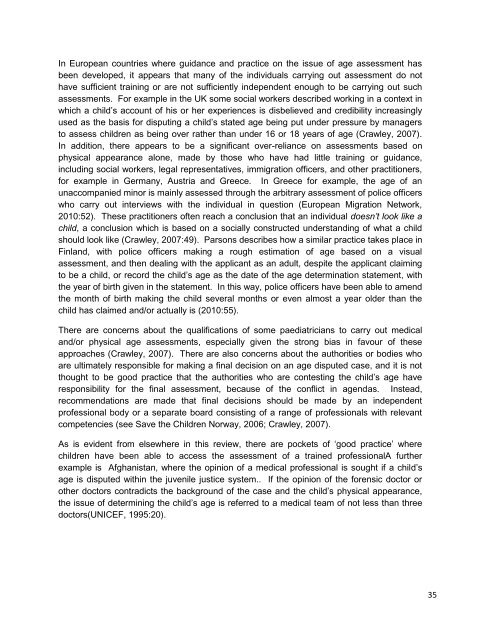Age assessment practices: a literature review & annotated ... - Unicef
Age assessment practices: a literature review & annotated ... - Unicef
Age assessment practices: a literature review & annotated ... - Unicef
Create successful ePaper yourself
Turn your PDF publications into a flip-book with our unique Google optimized e-Paper software.
In European countries where guidance and practice on the issue of age <strong>assessment</strong> has<br />
been developed, it appears that many of the individuals carrying out <strong>assessment</strong> do not<br />
have sufficient training or are not sufficiently independent enough to be carrying out such<br />
<strong>assessment</strong>s. For example in the UK some social workers described working in a context in<br />
which a child‟s account of his or her experiences is disbelieved and credibility increasingly<br />
used as the basis for disputing a child‟s stated age being put under pressure by managers<br />
to assess children as being over rather than under 16 or 18 years of age (Crawley, 2007).<br />
In addition, there appears to be a significant over-reliance on <strong>assessment</strong>s based on<br />
physical appearance alone, made by those who have had little training or guidance,<br />
including social workers, legal representatives, immigration officers, and other practitioners,<br />
for example in Germany, Austria and Greece. In Greece for example, the age of an<br />
unaccompanied minor is mainly assessed through the arbitrary <strong>assessment</strong> of police officers<br />
who carry out interviews with the individual in question (European Migration Network,<br />
2010:52). These practitioners often reach a conclusion that an individual doesn‟t look like a<br />
child, a conclusion which is based on a socially constructed understanding of what a child<br />
should look like (Crawley, 2007:49). Parsons describes how a similar practice takes place in<br />
Finland, with police officers making a rough estimation of age based on a visual<br />
<strong>assessment</strong>, and then dealing with the applicant as an adult, despite the applicant claiming<br />
to be a child, or record the child‟s age as the date of the age determination statement, with<br />
the year of birth given in the statement. In this way, police officers have been able to amend<br />
the month of birth making the child several months or even almost a year older than the<br />
child has claimed and/or actually is (2010:55).<br />
There are concerns about the qualifications of some paediatricians to carry out medical<br />
and/or physical age <strong>assessment</strong>s, especially given the strong bias in favour of these<br />
approaches (Crawley, 2007). There are also concerns about the authorities or bodies who<br />
are ultimately responsible for making a final decision on an age disputed case, and it is not<br />
thought to be good practice that the authorities who are contesting the child‟s age have<br />
responsibility for the final <strong>assessment</strong>, because of the conflict in agendas. Instead,<br />
recommendations are made that final decisions should be made by an independent<br />
professional body or a separate board consisting of a range of professionals with relevant<br />
competencies (see Save the Children Norway, 2006; Crawley, 2007).<br />
As is evident from elsewhere in this <strong>review</strong>, there are pockets of „good practice‟ where<br />
children have been able to access the <strong>assessment</strong> of a trained professionalA further<br />
example is Afghanistan, where the opinion of a medical professional is sought if a child‟s<br />
age is disputed within the juvenile justice system.. If the opinion of the forensic doctor or<br />
other doctors contradicts the background of the case and the child‟s physical appearance,<br />
the issue of determining the child‟s age is referred to a medical team of not less than three<br />
doctors(UNICEF, 1995:20).<br />
35
















